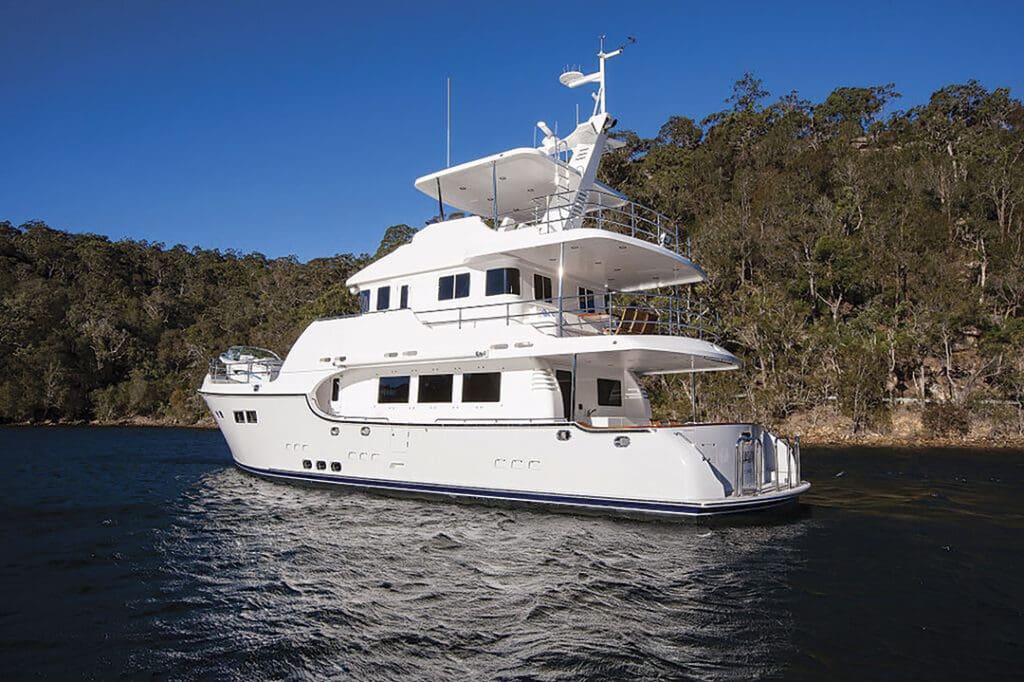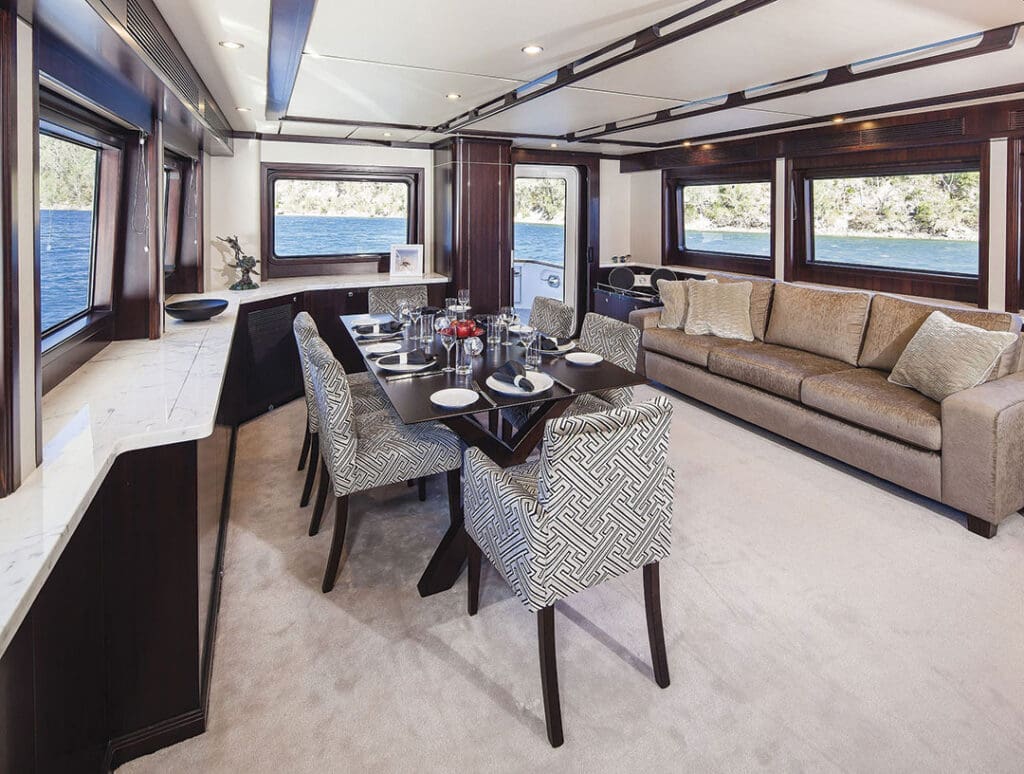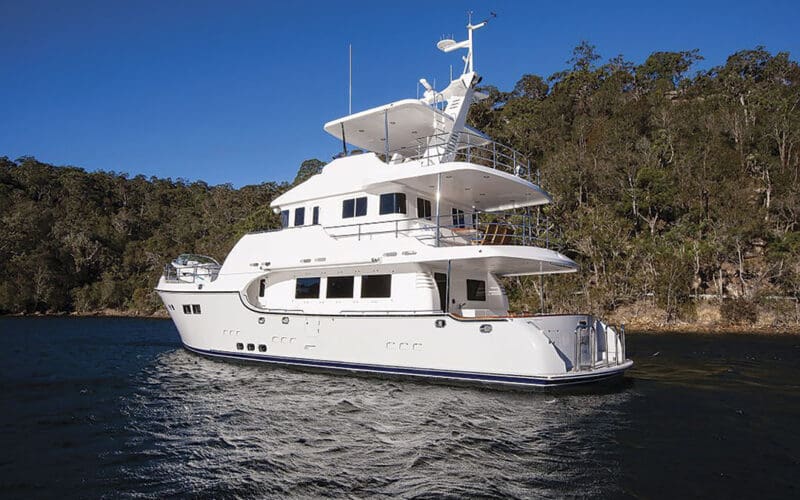
Many of us who cross oceans on rough-going sailboats often wonder what it would be like to undertake voyages in comfort and style while maintaining a good turn of speed over the water at the same time. After all, crossing oceans doesn’t have to be painful or complicated. Hence the choice of a larger, faster, more comfortable motor yacht.
If you are ready to invest in a vessel that provides for all your passage-making requirements while keeping you comfortable while on the high seas, consider the Nordhavn 68, by Nordhavn, a builder of high-end luxury motor yachts in Dana Point, Calif. Nordhavn yachts include plush cabin features and fuel-efficient propulsion plants, along with aggressive electrical generating and power storage systems, designed to take you across the world’s oceans in comfort and safety.
Amenities
The skipper of a new Nordhavn motor yacht can look forward to a long list of amenities, which include a wide array of electric appliances and deck systems. In the galley you will find a large, front-opening refrigerator and freezer, an automatic dishwasher and a trash compactor. Nearby you will find a stacked washer-and-dryer combo, allowing crew and passengers to maintain a freshly cleaned wardrobe throughout an entire voyage, something unheard of on a small, humble sailing yacht.
Out on the foredeck of the N68 you will see a heavy-duty electric crane for lowering and retrieving your ship-to-shore motor launch. Just forward of the crane is a Maxwell 4500 vertical electric windlass with dual station controls, capable of pulling up to 4,500 pounds of ground tackle. That is certainly more than enough power to retrieve any conceivable size of anchor-and-chain combination for this size of vessel, even in a stiff breeze. The unit draws 2 kW of DC current, which is backed by a generous source of generator and battery power.

Navigation
Each Nordhavn yacht has a custom-designed and installed navigation station to meet the specific needs of the owner. As Robert Kinney of the Nordhavn electrical subcontractor Alcom Marine explains, the typical coastal mariner usually opts for a minimal array of navigation and communication devices, including a VHF radio, radar and chartplotter.
On the other hand, a N68 outfitted for offshore cruising carries two depth sounders, radar, two autopilots, magnetic and satellite compasses and other redundant systems. “The ocean crosser has complete duplication,” Kinney emphasizes. Offshore, opting to repair or switch out equipment is not practical, particularly in inclement conditions or in a crowded seaway within 100 miles of a harbor.
While underway, the total electrical draw for the entire nav station, along with various other electrical appliances and systems throughout the vessel, is 30 to 40 amps, which is easily backed by ample battery storage and power-generating capacity. And of course, all electronic installations meet or surpass American Boat and Yacht Council (ABYC) and applicable international standards to ensure safety and maximum functionality.
Main and Auxiliary Propulsion
The main propulsion engine is a 425-horsepower John Deere, keel cooled and with dry exhaust. The gear box, or transmission, is a Twin Disc with electric shift and clutch. Racor vents and air cleaner system keep the engine room atmosphere clean for crew. Also, a Racor fuel filter with 2-micron filter elements is used for both the main and auxiliary engines. The N68’s main propeller is a Hung Shen “Silent” four-blade, left-hand unit measuring 44 inches by 34.5 inches.
The auxiliary engine is a John Deere rated at 160 horsepower and cooled by a heat exchanger. A “V” drive Hurth Marine gearbox transmits power to a 1-3/4-inch shaft with a Gori three-blade folding prop.
Vessel Stabilization
All vessels, power or sail, regardless of size, are subject to constant wave action while navigating offshore hour after hour, day after day throughout the entire voyage. On a sailboat, the sails help to attenuate this sideways action by constantly slicing through the air and stabilizing the vessel with opposing atmospheric resistance.
On large motor yachts, such as the N68, the same sideways resistance is achieved via stabilizer fins placed on the hull underwater. Vessel stabilization is controlled by an electronic gyro that detects the rate and speed of roll in the hull, sending corrective action to the stabilizer fins while underway. Mechanical power is transmitted to the vertical-axis fins by an electronically activated hydraulic pump and a set of control valves.
For stabilizer fins to work properly, the vessel must be underway to allow Bernoulli’s Principle to take effect. Just as with a set of sails, the faster a fluid mass passes over a foil, the lower the pressure on one side and the greater the righting force at the side facing the oncoming water current. With a pair of stabilizer fins and a vast store of battery power to back them, passengers and crew can expect a consistently smooth ride in virtually all conditions.
Charging and Monitoring Systems
While traversing an ocean on your Nordhavn yacht, you certainly will want to watch videos, talk on the radio, take a hot shower and enjoy the AC at your whim without worrying about battery charge. A Nordhavn yacht’s array of AGM batteries requires an aggressive charging and monitoring system capable of keeping up with the huge storage capacity.
The most critically important battery on any motor vessel is the starter bank, which needs to be fully charged and ready to use at a moment’s notice. The two 4D starter batteries are charged by a dedicated 40A, 24V alternator, and the house bank is charged by two 175A, 24V DC belt-driven alternators. Although both alternators are powered by the engine, they, along with the two separate battery banks, are isolated from each other to prevent power loss in both banks.
In addition to the alternator, a 27.5 kW Onan generator provides house power within a sound enclosure to dampen noise. The generator uses a wet exhaust system similar to that found on main engines in smaller vessels.
Redundancy
Redundancy in electrical storage and wiring is Nordhavn’s way of ensuring, to the best of the company’s ability, the smooth, uninterrupted operation of all onboard systems, be they for navigation or for crew comfort and convenience. The large AGM battery storage system and electrical inverters, powered by an Onan 27.5 kW, 120/240V AC, 60 Hz generator, allow batteries to support many of the vessel’s electrical components. This permits constant use of lights, air conditioning units, cooking appliances, watermakers, a washing machine and dryer and so forth around the clock while underway or at anchor.
Much of the overall safety of the N68 and other Nordhavn yachts lies in the company’s obsession with not only oversizing copper cables, but also doubling them in critical, high-current installations, particularly from the main battery bank to the propulsion engine and from the auxiliary banks to the Victron Quattro inverters.
On yachts with lithium-ion house batteries, the huge amounts of power packed into 8D and 4D banks can generate a much larger amount of heat over a given length and size of wire than flooded or AGM batteries. This equates to greater stress on cables, connections, switches, fuses, circuit breakers and other electrical components.
For this reason, Nordhavn ensures oversized copper cables and wiring are standard in all installations. As a matter of fact, even in Nordhavn yachts still being sold with AGM batteries, the builder has begun upgrading all wiring installations to meet the demands of lithium-ion amperage and power requirements in anticipation of new owners opting to upgrade to the latest battery technology.
And just for good measure, even the cords connecting shore power to the Quattro inverters are doubled in order to reduce heat and electrical resistance in the copper cables, essentially eliminating any chance of overheating in the shore cables.
While small-boat skippers may view the probability of overheating in electrical wiring as a minor, easily-managed concern, the captain of a large, ocean-going vessel such as the N68 or other model knows managing the sheer amount of electrical current at every corner of the vessel plays a critical part of the boat’s safety at anchor, at dockside and while underway.
Nordhavn is the quintessential example of a yacht builder committed to ensuring quality and safety in all its vessels.

